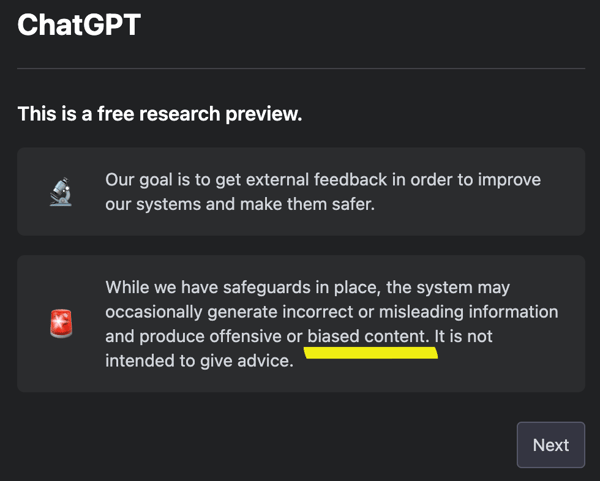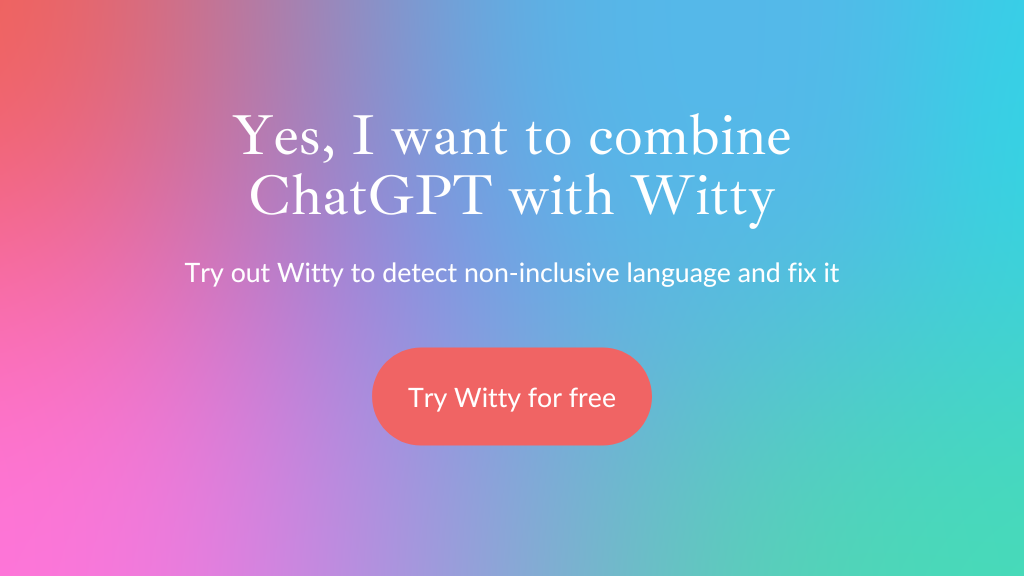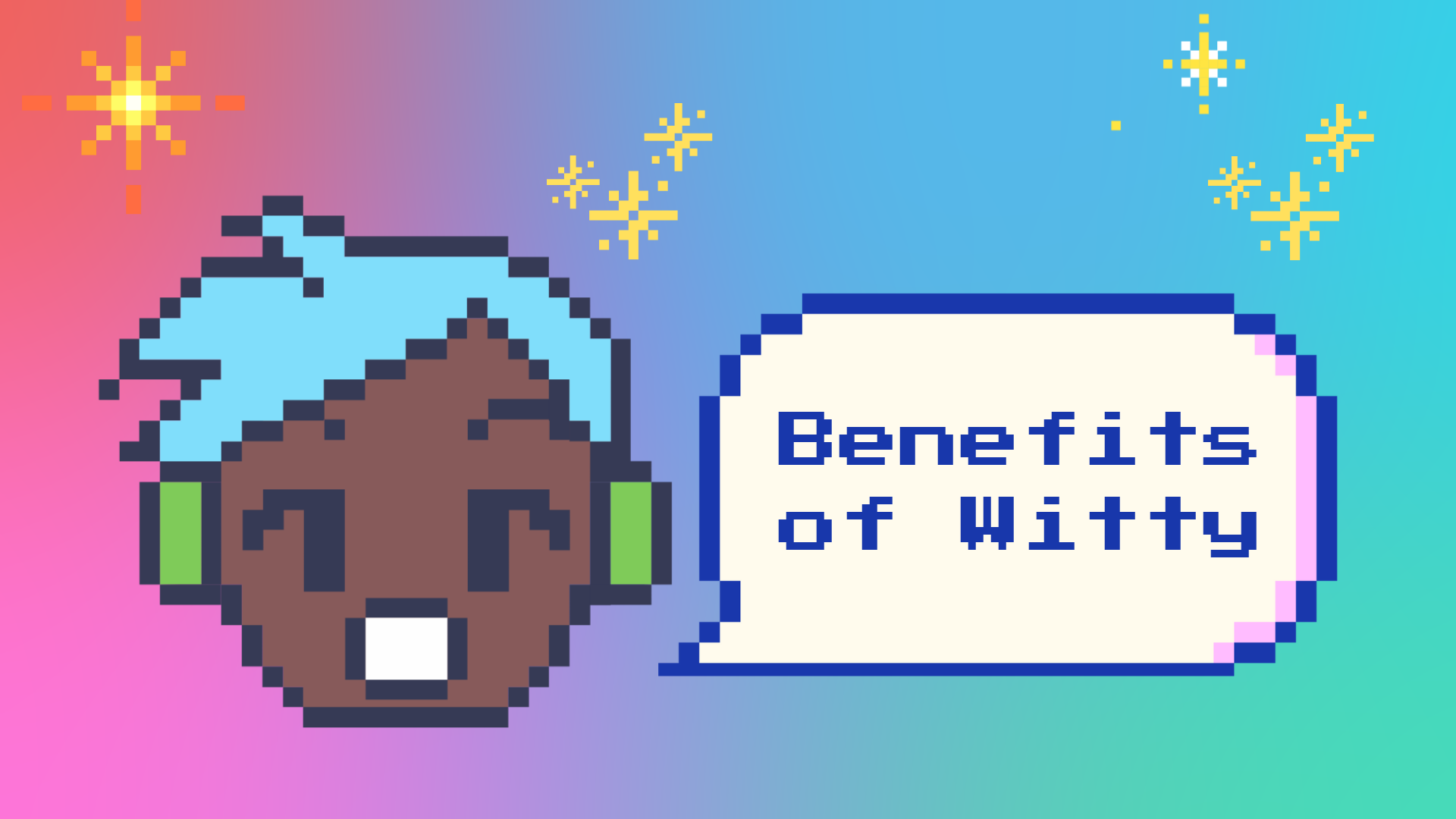ChatGPT and other so-called “generative language models” have a huge potential to change how we work and write. It will help marketers, content producers and UX writers to be faster and more creative. It's clear: Such language models will highly impact how we communicate with each other.
However, such language models also bear a risk: They tend to replicate stereotypes and biases that are deeply rooted in our society and business world. Why? Because they feed themselves of past, human-generated content. Open-AI, the sponsor of ChatGPT, even makes aware of this in their FAQs.

One of several warning messages shown after logging into ChatGPT.
Hence, for marketers and other content producers there is a crucial risk: Such language models replicate biases that could deter our target groups, especially those with diverse backgrounds. We know from a study of Microsoft, that 70% of GenerationZ trust brands that have inclusive ad campaigns. Especially in our marketing and sales communication, we know that we must be very sensitive in how we communicate. That’s why Inclusive Language was thought of in the first place: to cast aside - often unconscious - bias and stereotypes. We cannot and should not discriminate nor exclude anyone. It hurts our business and our reputation and we won't be attractive for new talents.
In marketing or employer branding campaigns, marketers or HR representatives want to make sure that we address and involve everyone and make everyone feel that they belong. Inclusive Language is a lever for generating more inclusion in such a diverse world and market as we have today. But using such language models could be contrary to that goal.
Seeing the wide adoption of ChatGPT-produced content on the horizon - and thus the risk that stereotypes get replicated and our target groups excluded -, we wanted to test if we can use ChatGPT without much hesitation when creating content. Or in other words: Are generative language models able to produce Inclusive Language?
In order to find out, we conducted an experimental study with regard to the following questions:
- Can ChatGPT generate Inclusive Language when instructed to do so?
- Can it explain its choices?
- If ChatGPT and an Inclusive Language AI are combined, can we make sure that content is written inclusively?
In the study, we give an overview of how ChatGPT works, its strengths and weaknesses, with a particular focus on bias and whether Witty is different. We detail our experiment to illustrate those strengths and weaknesses in practice. Most importantly, we show how ChatGPT can benefit from being combined with Witty to produce content using inclusive language.
Download our study. It's free!
Outcome
Here is a high level result of the experimental study:
|
ChatGPT |
Witty* |
|
Provides varied text output and explanations to what it did, but stays susceptible to stereotypes. |
Provides consistent and reliable output, identifying and explaining bias in many diversity dimensions. |
|
Can explain changes if prompted to do so. However, this requires expertise in Inclusive Language to determine if the response is correct. |
Automatically provides explanations for every biased word. |
|
Can be fine-tuned, e.g. if data is added it can learn to execute a new specific task. |
Supports the creation of a personalized dictionary and language customization |
|
Language model evolves in spurts, e.g. GPT models are always trained on data up to a specific date only. They only replicate the past and the standard from the majority. |
Language model evolves quickly and continuously as new inclusive words are added daily. That's also why it picks up growing linguistic trends of social movements. |
* Beware: Witty never writes for you. You write and Witty assists you in formulating your text inclusively.
Best of both worlds: ChatGPT in combination with Augmented Intelligence
We found ChatGPT is limited in its capacity to produce Inclusive Language. However, combining it with an inclusive language NLP platform like Witty produces a “best of both worlds” solution: We can use generative language models such as ChatGPT to quickly and automatically produce high-quality content and then apply Inclusive Language curation through an Augmented Intelligence solution like Witty to certify the content aligns with inclusivity expectations.
Our recommendation
For all marketers and content producers, who need to make sure their content is inclusive, we recommend combining ChatGPT with an Augmented Intelligence solution for Inclusive Language to produce consistent, high-quality inclusive results.
Witty can easily be integrated into standard ChatGPT workflows. Even though ChatGPT’s context awareness has shown to be notable, Witty is a more powerful tool with respect to Inclusive Language due to its specialization and its basis in manually curated, high-quality datasets. Also, Witty educates users on topics of diversity and inclusion.
Witty can help you to safeguard that generative language models are used responsibly and inclusively in your team. Or, as we sweetly put it: Witty is here to be your Inclusive Whisperer of large Language AI models.
PS: If there is interest in a closer integration between ChatGPT and Witty, please let us know on our roadmap.
This blog post was written jointly with Prof. Dr. Mascha Kurpicz-Briki from Berner Fachhochschule. She does research in Applied Natural Language Processing, Fairness and Diversity in Natural Language Processing, and Augmented Intelligence for Humanities and Health.






